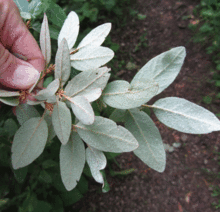Vaccinium myrtilloides
| Vaccinium myrtilloides | |
|---|---|
 | |
| Conservation status | |
| Scientific classification | |
| Kingdom: | Plantae |
| (unranked): | Angiosperms |
| (unranked): | Eudicots |
| (unranked): | Asterids |
| Order: | Ericales |
| Family: | Ericaceae |
| Genus: | Vaccinium |
| Species: | V. myrtilloides |
| Binomial name | |
| Vaccinium myrtilloides Michx. | |
Vaccinium myrtilloides is a shrub with common names including common blueberry, velvetleaf huckleberry, velvetleaf blueberry, Canadian blueberry, and sourtop blueberry.[1] It is common in much of North America, reported from every Canadian province plus the Northwest Territories, as well as from the northeastern and Great Lakes states in the United States. It is also known to occur in Montana. [2]
Description
Vaccinium myrtilloides is a low spreading deciduous shrub growing to 50 cm tall, often in small thickets. The leaves are bright green, paler underneath with velvety hairs. The flowers are white, bell-shaped, 5 mm long. The fruit is a small sweet bright blue to dark blue berry. Young stems have stiff dense bristly hairs. [2]
This plant grows best in open coniferous woods with dry loose acidic soils; it is also found in forested bogs and rocky areas. It is fire-tolerant and is often abundant following forest fires or clear-cut logging. Vaccinium myrtilloides hybridizes in the wild with Vaccinium angustifolium - lowbush blueberry.
Characteristics
This native plant is also cultivated and grown commercially in Canada and Maine, mainly harvested from managed wild patches. Vaccinium myrtilloides is one of the sweetest blueberries known.
It is also an important food source for black bears, deer, small mammals, and birds.
See also
References
- ↑ Michaux, Flora Borealis-Americana 1: 234. 1803.
- ↑ 2.0 2.1 Flora of North America vol 8 p 529.
